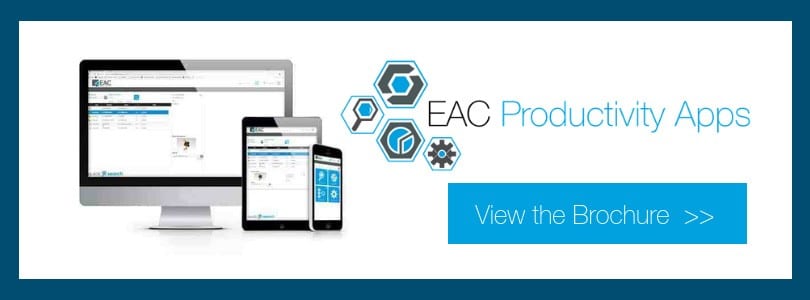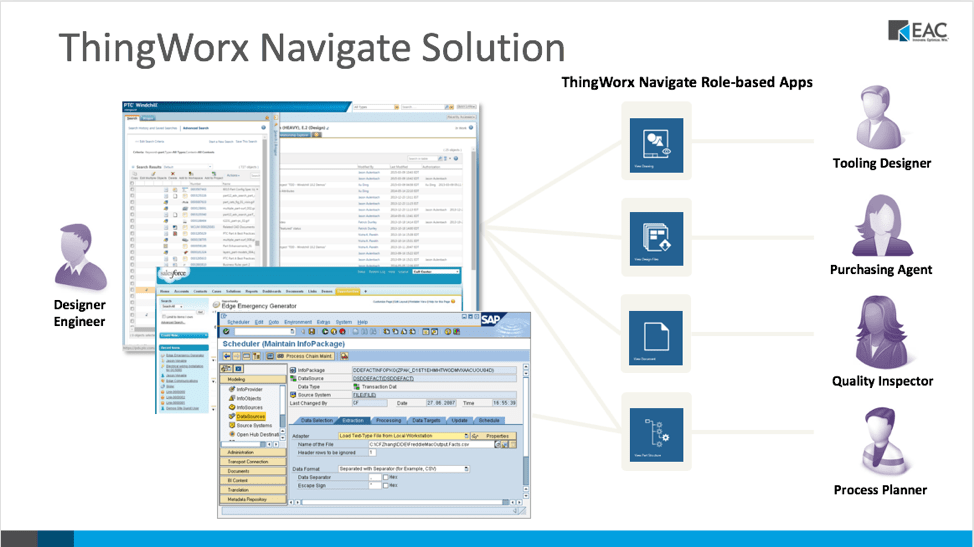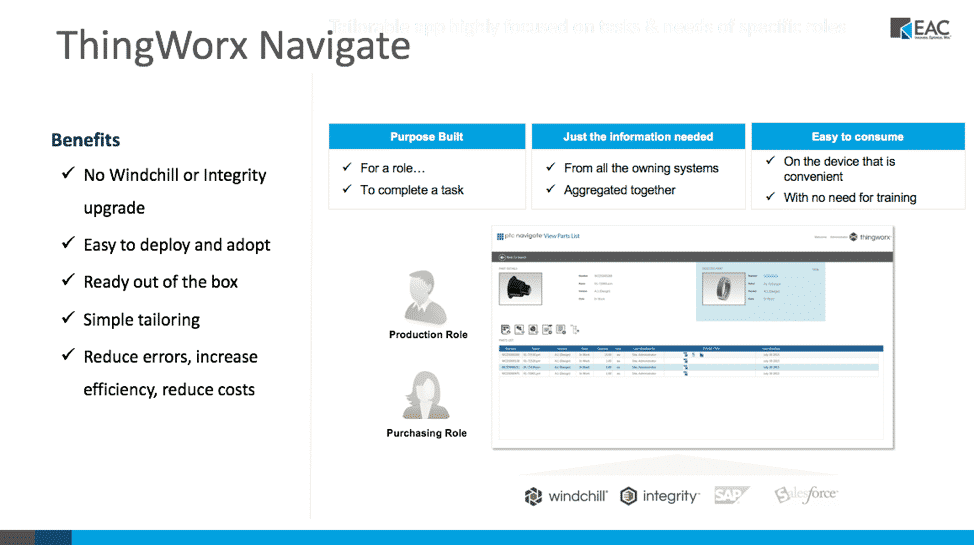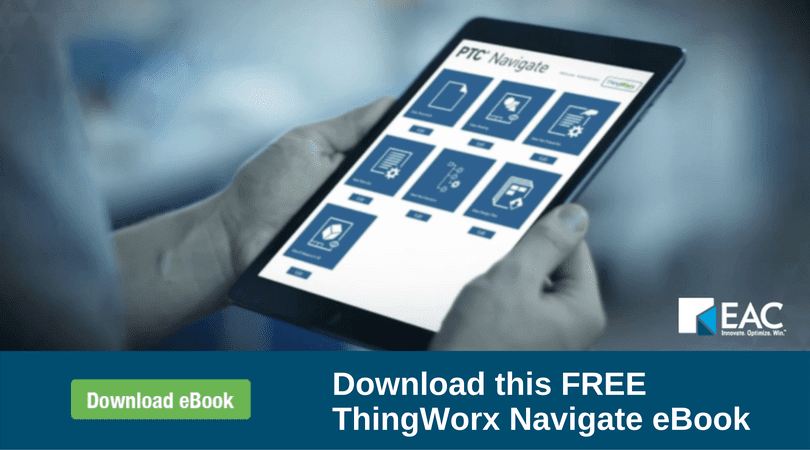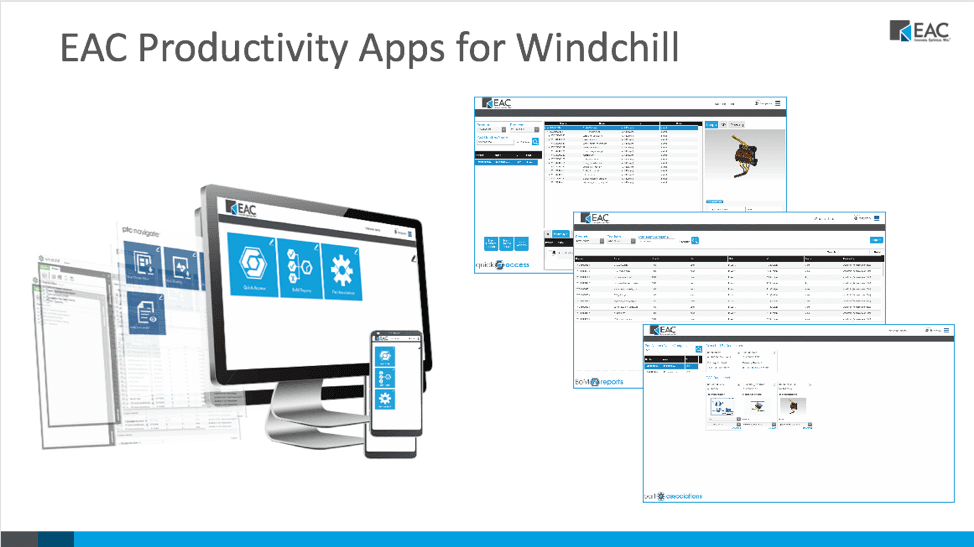Here’s why every manufacturing company should be considering product lifecycle management applications.
Expand PLM software usage throughout your enterprise with PLM apps
Let’s face it, no company uses a single product data management system (PDM) or a Product Lifecycle Management (PLM) system for ALL of its organization’s needs.
Your organization likely uses an abundance of different technology software to collect and store data. These technologies can include customer relationship management (CRM) systems, quality management system (QMS) software, enterprise relationship planning (ERP) systems, application lifecycle management (ALM) systems, and so many more.
If your organization currently uses a PLM system, odds are you most likely paid a pretty penny for it. So why not make the most of that product lifecycle system investment and use your system’s complete functionality?!
Product lifecycle applications support, enable, and enhance the value and footprint of PLM software. PLM Apps go a long away to assist and ensure consistent access to up-to-date product data. They can help expand controlled access to valuable content and give functional groups a single simplified view of files, data, and content all within a single browser-accessible screen.
You’re going to want to invest in these kinds of advanced technology solutions that simplify data gathering processes and expand the value of your PLM investment. PLM apps are meant to help you find data easier which reduces user frustration and helps take productivity to new levels within your organization.
PLM applications, also referred to as PLM system plugins, deliver on the dreams of many organizations. They are a simple solution that drastically increases enterprise PLM usage.
PLM apps integrate siloed data from disparate systems
With the use of multiple complex enterprise systems, your organization’s data is most likely held captive in siloed systems. Many PLM applications help connect these disjointed enterprise systems using common application programming interface (API) connection abilities.
PLM apps simply pull data from other enterprise systems into a new user-interface through API integrations. They don’t rely on interface features from other enterprise platforms or systems (besides the data and information they extract), therefore, they are less likely to be affected by a new release of the underlying enterprise systems!
PLM apps simplify searches for the occasional PLM software user
PLM apps change the user interface (UI) and user experience (UX) of your PLM system so that it’s easier to use. This can be useful for occasional or novice users who can feel overwhelmed by the complexity of their PLM system compared to those that use their PLM system on a daily basis.
PLM applications offer user-friendly interfaces that simplify the complexity of PLM systems and make it easier to search, find, locate, and understand product information. In fact, many of these tools even allow organizations to adjust settings for specific users (such as purchasing, marketing, accounting, etc.) so they can access the direct information they need.
PLM apps Many customers we work with use complex product lifecycle management systems such as PTC Windchill or Siemens Teamcenter. Due to the robust capabilities of these enterprise systems (and other PLM systems), many users find product data hard to navigate – especially if they aren’t daily users within these systems.
PLM apps speed up product development processes by providing users with complete access to real-time complex enterprise data.
Product lifecycle applications really do make PLM easier – see it for yourself by watching this short PLM applications video.
Customize PLM apps without disrupting your PLM software
PLM applications and system plugins offer simple and easy ways to customize enterprise product data systems. A PLM Administrator can customize the apps to conform to their company’s goals and prioritization of tasks without disrupting the PLM software itself.
Time after time, we see organizations add PLM customizations to their mainframe PLM software, only to wind up facing dozens of challenges as new system software versions get released. Because PLM apps are an extension of PLM software systems, they are minimally affected by upgraded software versions and updates (if at all).
PLM apps provide organizations with the ability to easily custom tailor simplified product lifecycle management interfaces or mashups. This functionality provides additional value and integration capabilities with other enterprise systems.
PLM Applications offer a brand-new UI for your intricate product data management system; enabling a fresh and simple user experience. They also have started to help organizations solve problems easier and faster with direct, accessible, and instantaneous insights from data.
Your systems are only as good as how you use them. If employees struggle to navigate your product lifecycle system interface, PLM apps are definitely something you should be looking into!
How PLM apps drive flexibility within your organization
PLM applications provide access to PLM information to employees outside of engineering such as marketing, sales, finances, and procurement.
Access to PLM system data provides another way for teams to identify the broad scale of their day to day activities and information. This can help teams understand and prioritize tasks to be more efficient and productive.
This flexibility allows teams to work the way they want. By enhancing a complex system and tailoring each end-user experience, it’s easy to see how these PLM system plug-ins can drastically improve productivity and drive value across an organization.
What is better than providing every department with product information that they want and need to do their job?!
Want to learn more about PLM Applications and how they could pair up with your current enterprise systems? Let’s have the conversation!
You’re likely to have experience with Bill of Materials (BoMs) if the nature of your business has anything to do with product development.
Let’s talk about why bill of materials are so important, how BoMs impact business, and the best BoM management practices. Or check out another helpful article on BoM management, “How BoM Management plays a role in your PLM processes“.
The importance of bill of materials
BoMs define products as they are designed (CAD or engineering bill of materials), as they are ordered (sales bill of materials), as they are built (manufacturing bill of materials), and as they are maintained (service bill of materials).
They incorporate product information from design and engineering, document control, operations, manufacturing, purchasing, contract manufacturers, and more. Bill of materials influence inventory levels, material purchases, shop floor assemblies, and so much more.
In fact, departments often rely on BOM records to get the job done right. Whether you realize it or not, your BoMs drive and affect your businesses’ operational success. This is why it is so important that your organization creates and manages well-organized, correct and up-to-date bill of materials.
BoM information accuracy and why it matters
BoMs require complete and accurate information, in order to successfully benefit design, manufacturing, sales and service building quality products.
The accuracy of BOMs influences an organization’s ability to make well-rounded product development decisions. These decisions fundamentally impact the efforts organizations peruse to generate a product in the most efficient, cost-effective way.
Oftentimes creating BOMs requires input from design, procurement, manufacturing, and sales. Using manual methods to collect and enter items on various BoMs increases the risk of producing inaccurate, out-of-date, or even possibly duplicate BoM versions.
Furthermore, if departments produce products based on incorrect or inaccurate bills of materials, delays to market can occur. This can not only be very costly for an organization, but it oftentimes impacts an entire supply chain.
Inaccurate bills of materials are one of the costliest errors engineering companies can make. In order to avoid the risks of inaccurate BoMs, many organizations have started to reevaluate the way they create, manage, and share product information.
BoM management processes
Bills of materials (such as eBoMs, sBOMs, mBoMs) are most-likely part of your product development process. That being said, what are your current processes for managing those BoMs?
How do you share, collaborate, and ensure the accuracy of your organizations’ bills of materials? Do you find it difficult to manage the differences between them and keep the data consistent across eBOM (engineering bill of materials) and mBoMs (manufacturing bill of materials)?
Odds are if you have yet to implement technology solutions to manage your bills of materials, your methods for BoM management most likely involve spreadsheets, emails, rekeying information, and multiple other systems of communication.
If this is the case, don’t worry – you’re not alone. Studies show nearly 50% of product development companies still use spreadsheets (or sometimes even nothing at all) to manage complex bill of materials!
Despite the big workload that BoM management represents, many organizations are still comparing bills of materials in excel spreadsheets or by opening separate BoMs and manually connecting the dots. This management approach is not only tiring, but it also increases risks of human error and mistakes, especially if the bills of materials are very long.
In fact, is not unusual to find one giant excel spreadsheet on top of information managed by PLM (product lifecycle management), ERP (enterprise resource planning), CRM (customer relationship management) and other databases. Why is that? The information required to assemble bill of material documents tends to reside within separate, disconnected enterprise systems.
It’s time to change that.
Connecting business systems and information
In a world of complex, role and department-specific enterprise systems, productivity can seem quite limited. But the truth is, with the help of technology, businesses no longer need to operate this way. Collaborative solutions exist, and they really are as simple to implement as they, well… should be.
System integration tools (such as applications) change the way organizations create, manage, and share product information- without even having to upgrade or change current enterprise systems.
Using system API connections, applications can pull data from disconnected enterprise systems and consolidate it into centralized dashboard display windows. In fact, many integration applications are even ready to go straight out-of-the-box (yes, this means they require absolutely no special configurations or complicated implementation at all).
For instance, productivity apps offer simple, role-based access to data and other enterprise systems making it easier for stakeholders to view and understand consolidated product information and data. What makes simple applications that integrate enterprise data even better is the fact that most of these system collaboration tools are even affordable.
With a single view to into multiple enterprise systems (such as ALM, MRP, ERP, SLM, CRM, Accounting, and PLM) you can be sure that users have access to the latest and most accurate product information when they need it, and how they need it. There’s really no catch. Productivity apps really are solutions that are; easy, affordable, and that solve the complexity of dealing with multiple disconnected enterprise systems.
Effective BoM management & bill of materials software
Parallel to system integration apps that can pull and consolidate enterprise data, BoM applications can also automatically consolidate real-time data across enterprise systems.
This means organizations can enable real-time BoM collaboration – and that is a game changer.
Real-time BoM collaboration empowers users with capabilities to collaborate and work together creating a bill, sharing BoMs and associated data, and even preview CAD drawings and images. It also opens up the ability to simultaneously edit manufacturing bill of materials, while completely avoiding duplicate and inaccurate documents. This enables users to get a virtual ‘live view’ of data.
Users are able to maintain and manage all associated product documentation such as part datasheets, materials required, CAD drawings and files, as well as anything else that is needed to manufacture a product all in one centralized location. This reassures one sole accurate and revision-controlled bill of material for a product.
This is exactly why it is so important to establish systems and methods that enable all departments within your product development process to be able to share, collaborate, and ensure the accuracy of your bills of materials.
A simple bill of materials software
Our experts at EAC Product Development Solutions recognized the need for better BoM management within many organizations- That’s why we created our bill of materials software application, BoM Reports.
Our BoM Reports PLM application is essentially an out-of-the-box PLM system plugin. It’s easy to use, simple to integrate, and an extremely affordable for any organization.
We designed our Bill of Materials Reports application with the intention of making manufacturing bill of materials and engineering bill of materials management ‘easy’ for organizations of all sizes. Meaning- our bill of materials software can even work for small businesses!
Our BoM Reports app delivers access to your accurate bill of materials database while it provides visual representations, cost rollup for materials, and detailed informational listings of items within bill of materials.
We guarantee our BoM Reports application will enhance your bill of materials management. In fact, it has changed the way many of our customers do business.
Our EAC Productivity app enables purchasers to see product cost roll-ups during design, so they can hit cost targets. It allows project managers to see the highest level status and availability of constituent parts so they can keep projects on time and budget. It helps fabricators see what version of parts go into the build so they can prevent scrap and rework- and SO much more!
We’re excited about how our organization is enhancing product development and we would love to share more information with you about how our EAC productivity apps really work.
If you would like more information about apps that could work for your business insert your information below. We promise not to fill up your inbox with overloads of information, we simply want to share tips, tricks, and tools that will help your organization succeed.
Data Visualization and system integration tools are shaping the future of business and I am going to explain exactly why.
First, it is essential that you understand the impacts of technology and data today.
The impacts of big data
Humans collectively produce approximately 2.5 quintillion bytes of data each day and this number is only increasing with the acceleration of the Internet of Things (IoT). These already astonishing statistics are growing at an ever-increasing rate as our world becomes even more digitized and data-centric.
Due to this overwhelming growth, businesses have begun facing challenges with data capture, analysis, distribution, storage, and visualization. In fact, big data has started to become so large and so complex that businesses are even finding traditional data processing techniques to be inadequate. This is exactly why system integration and business intelligence software have become essential components for successful business data management strategies.
System integration and system integration tools
Enterprise application integration software combine components of sub-systems together into one centralized system. Essentially, system integration applications ensure all business systems function together as one.
For instance, integration applications (such as EAC Productivity Apps) connect existing systems and enable seamless data to flow from various systems into role-based dashboards or “mashups.”
By using applications that integrate all of your business systems, your organization opens up a clear, efficient path, for information to travel from one application or system to another. The process of linking together different computing systems and software applications opens up an organization’s ability to easily collect, aggregate, and share data.
Business intelligence
The trend towards business intelligence (BI) has driven many companies to evaluate technology-driven processes for analyzing data and presenting actionable information.
Common functions of business intelligence technologies include reporting, analytics, data mining, process mining, business performance management, benchmarking, predictive analytics and prescriptive analytics.
BI technologies can handle large amounts of structured and sometimes unstructured data to help
System integration, Bi, and data visualization
Tools and applications that integrate business systems incorporate oftentimes incorporate data visualizations, also known as data dashboards.
Data visualizations deliver graphical representations of data or information, often in the form of a chart, diagram, picture, or any other visual illustration. Visual representations of data and information help humans understand the significance of data by transforming it into information placing it in a visual context.
Human visual processing is efficient in detecting changes and making comparisons between quantities, sizes, shapes, and variations in lightness. When properties of symbolic data are mapped to visual properties, humans can browse through large amounts of data efficiently.
If considering the way the human brain processes information, using charts or graphs to visualize large amounts of complex data is much easier than attempting to analyze multiple different spreadsheets or reports. By using visual elements like charts, graphs, and maps, data visualization tools provide an accessible way to see and understand trends, outliers, and patterns in data.
The impacts of data visualization
Data visualization enables executives, managers, and other corporate end users, to easily digest huge amounts of data by displaying visuals.
These data visuals encourage decision makers to compare sizeable amounts of information while data is being revealed beneath several levels of detail. This encourages the natural eye to compare and contrast different pieces of data, that may have otherwise been lost within reports.
System integration tools that collect data from internal and external systems and aggregate it into data dashboards, enable organizations to reason quantitative information. This helps executives, managers, and other corporate end users to better understand trends, patterns, and possible correlations. Data visualizations can also allow decision makers to make better business decisions.
Visual data representations of information assist decision makers in the absorption of information in new and more constructive ways. They encourage a user to think about the substance of the data rather than the methodology.
With the ability to manipulate and interact directly with data, organizations visualize relationships and pattern between operational and business activities. This allows them to identify and act on emerging trends faster, as well as, identify areas that need attention or improvement.
By using system integration business intelligence tools and applications, organizations can collect data from internal and external systems, prepare it for analysis, develop and run queries against that data, and create reports, dashboards and data visualizations to make the analytical results available to corporate decision-makers, as well as operational workers.
Think data visualization and system integration could be what your organization needs?
We offer EAC Productivity Apps as
These days product data is everywhere. Everyone seems to collect it, have a lot of it, but the question remains; how exactly can you ensure your organization’s product data is being put to good use?
It’s time to take your product development one step further by providing role-based data access, connecting your enterprise systems, and learning how to make the most of your product data. I am going to explain exactly how easy that is to do.
The current state of product data
Companies today have many different roles that require access to product data. This may include people outside of the typical roles of which you may be thinking.
Departments such as engineering, manufacturing, that’s a given, but expand your thinking to include operations, purchasing, and marketing. They all need data access in order to edit and consume information. Think about sourcing…I’ll stop there, but you get the idea.
Let’s focus on the engineering department for a moment.
People could be involved from the mechanical side, the electrical side, or even a quality standpoint. Beyond that, people need to either contribute or consume information that could include manufacturing, service, sales, and more.
Product data game-changers
Product data silos limit productivity – PTC & EAC have the answer.
PTC ThingWorx Navigate was designed to address data accessibility problems by providing simple role-based apps that deliver just the right information to different groups (or departments) in the way that they need
When non-engineering colleagues need access to vital information, they typically interrupt an engineer or designer with a request. ThingWorx Navigate eliminates that distraction and “double-billing.” Through role or task-based self-service applications, data can be securely shared with a team. That way non-expert teams can use a simplified user interface to access the product data they need, right when they need it.
To help accelerate product development processes and take product data even further, our company (EAC Product Development Solutions) has also created what we call EAC Productivity Apps that work alongside ThingWorx Navigate apps.
So what’s the difference between ThingWorx, ThingWorx Navigate and our EAC Productivity apps?
This is a great question- I am going to try and paint the picture for you.
First, it’s important that you understand what ThingWorx is and how it is different from ThingWorx Navigate.
ThingWorx is the proper name of PTC’s Internet of Things (IoT) platform comprised of 5 components; foundation, industrial connectivity, analytics, studio,
The foundation component is the heart of the ThingWorx loT platform used to make connections to ‘things’ which could be machines, products or software systems or pretty much anything with an IP address and a communications interface.
User interfaces to the data coming from these connections are displayed on websites called ‘mashups,’ created with ThingWorx foundation. You might know these perhaps as ‘data mashups’ or possibly as ‘data dashboards’. Simply put, Thingworx is the IoT platform that makes everything possible. (Here’s exactly what makes Thingworx the leading technology for industrial IoT)
Then you have ThingWorx Navigate.
ThingWorx Navigate is the proper name of PTC’s applications that
ThingWorx Navigate Apps use a Windchill (PLM) connector to extract product data for presentation to Windchill Product Lifecycle Management users.
Fundamentally, ThingWorx Navigate Apps are all simply data and product information mashups created with ThingWorx. With ThingWorx Navigate you receive out-of-the-box apps that are instantly ready to be used with your PLM system. The idea behind these product lifecycle management apps is to ensure users can capture the complete functionality of their PLM (product lifecycle management) investment.
ThingWorx Navigate PLM Apps include:
View Design Files – A design file would be a format of a file that isn’t the native CAD format. This could be a staph or Induce or perhaps a 3D PDF
View Drawing – Allows you to look at just drawings. This application pulls drawings from your Windchill PLM system.
View Part Properties – This feature allows you to look at part properties- as if you were hitting the ‘Information button’ next to a file.
View Parts List – Allows you to look at bills of Materials (BOMs)
View Part Structure– With the View Part Structure App, ThingWorx is actually going into PDMLink and showing different aspects of a specific part instead of different ways of going at it (such as having to open several different tabs to get information). Using this application, you can get all your information together on one page. This feature also includes capabilities that cross-highlight part structures within your product. For instance, you could select a component and it would highlight that part and create a hyperlink that allows you to directly look at that specific part. This feature essentially creates a mash-up that takes information from different places inside of Windchill PDMLink and brings them together putting them on one screen, allowing you to have all your information at your fingertips.
View Document & View Document Structure
If you would like to learn more about ThingWorx Navigate technology or if you have any questions, you can always request to talk with Thingworx Navigate specialists here.
PLM Applications created by EAC
Our EAC Productivity Apps (also known as product lifecycle applications)
They allow departments to access content and perform common tasks through a very simple interface, versus having to use a complex product lifecycle management system (PLM) or Enterprise Resource Planning (ERP) system.
PTC Navigate Apps vs. EAC Productivity Apps
Our EAC Productivity Apps provide capabilities beyond that of the out of the box ThingWorx Navigate apps.
In short, ThingWorx Navigate applications allow you to securely access and present role-specific data from your Windchill system. They provide all of the power of a Product Lifecycle Management (PLM) system to someone who is not familiar with its ins-and-outs of product data management.
EAC Productivity Apps take it a step further by taking the underlying technology of ThingWorx Navigate, and the ability to get at the information in the PLM system and create even more complete applications that really give individuals instantaneous access to the information and product data they need to do their job. EAC’s PLM applications are created using PTC’s ThingWorx IoT platform, however, they can run independently of ThingWorx Navigate.
These apps are unique to EAC.
While built using the same ThingWorx foundation, ADK and [Windchill connector], they have their own look, feel and functionality. These mashups are packaged and sold together as a collection. EAC Productivity Apps created for Windchill promote user adoption and amplify the return on the investment you’ve made in your Windchill system, as well as extending role-based visibility into relevant product data and the impact PLM has on your organization.
Take your product data further with EAC Productivity Apps
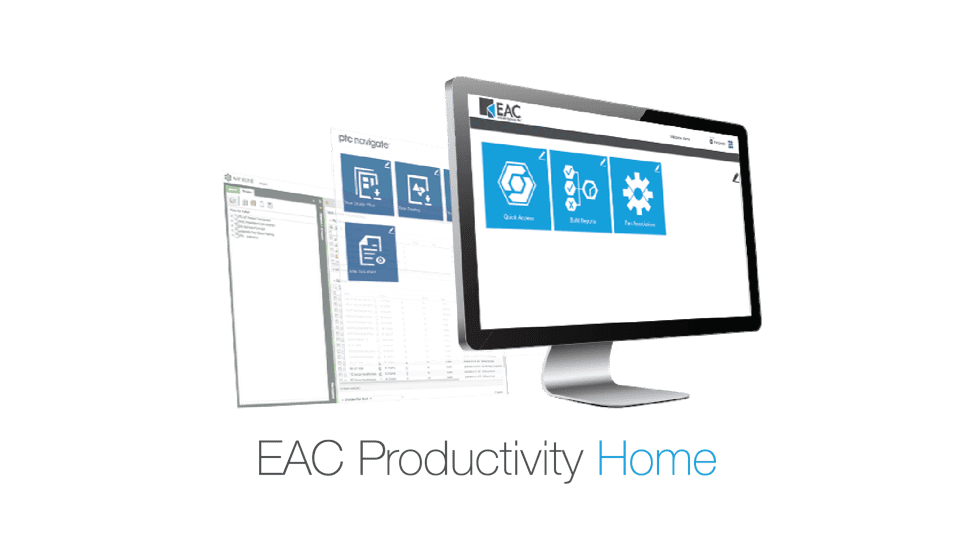
Every subscription of EAC Productivity Apps includes free access to EAC Productivity Home. EAC Productivity Home is a proprietary framework, or launcher, for ThingWorx Navigate applications.
It sits on top of Windchill and
The EAC Productivity App, Quick Search, provides a simple way for users to find content in Windchill. It removes the need for users to apply an understanding of how Windchill objects are related in order to find the information needed to do their job.
The Quick Search PLM application also allows users to search for components and retrieve information and file formats. For instance, if you were to grab a drive system and do a quick search, it’s going to find product information such as parts, EMP like documents, CAD files and more. See EAC Productivity Application Quick Search in action here.
You can also learn more about the Quick Search features in this brochure.
The Quick Access EAC Productivity Application streamlines access to critical and select data sets. Simplifies downstream users feeding critical quality information back to engineering with minimal effort.
This EAC Productivity App allows downstream users to feed critical quality information back to engineering with minimal effort. The simplified interface and consolidated task workflows help users easily submit new problem reports, new change requests, and new variances.
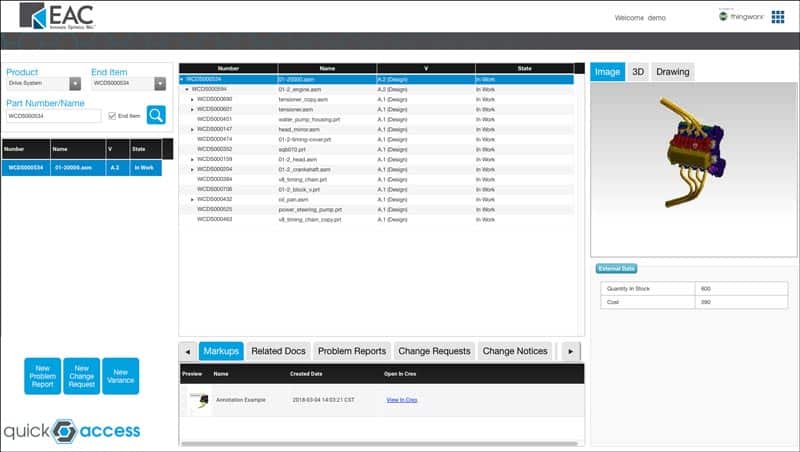
For instance, you could select a component (such as a product), pick its name (the end item number), search for it, and you would get straight to assemblies. With the use of Quick Access users can easily submit new problem reports, change requests, variances and more.
You can learn more about Quick Access features in this brochure.
The Part Associations EAC application provides a “shortcut” for non-CAD users to access critical files and documentation associated with designs like drawings, parts, assemblies, and other documents associated with CAD files and part data.
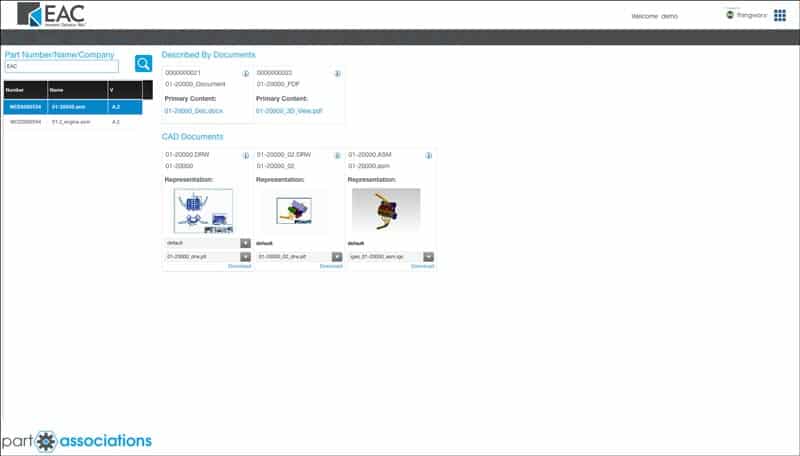
You can learn more about Part Association features in this brochure.
BoM Reports App provides a visual representation of cost
This EAC Productivity App allows users to quickly assess a Bill of Material and ensure projects stay on-time and on-track. The simplified view helps ensure products are built with the appropriate design iterations. With the use of BoM Reports users can easily see BoMs, lists of unreleased parts, parts that have been created or modified by specific users and more.
This app allows users to see the progress of a bill of materials, and apply filters to focus on parts that are not yet released. It is also useful for viewing all of the “make” parts or “buy” parts in a given BoM, or all parts created/modified by a particular user.
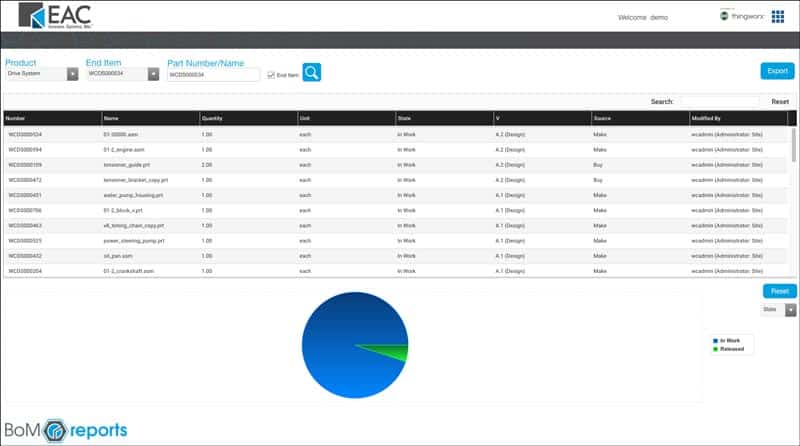
Get better access to your product data
See all the features of EAC P
What are PLM Apps?
Product Lifecycle Management (PLM) Applications (Apps) take data from your product lifecycle management software and combine it with data from your other enterprise solutions to create a single, accessible dashboard view (of all your data), that can be customized for any role within your organization.
Essentially, PLM Apps offer a comprehensive, basic IoT scheme to connect to your equipment, collect data, begin data/alert/notification workflows, deliver role-based dashboards, and more.
Here are four ways that PLM system applications could benefit your business.
PLM Apps, Systems, and more
Odds are, if your business is currently involved with the creation or production of any sort of product, you have likely heard of (or you might already be incorporating) product lifecycle management practices within your business. For those of you who are newer to the concept, product lifecycle management (PLM) often involves implementing software solutions referred to as product lifecycle management software, or systems.
Product management software systems (such as PTC Windchill, SAP PLM, Oracle Agile PLM, Teamcenter PLM, Autodesk Vault, Centric Software, Aras, etc.) are designed to manage your product’s entire lifecycle from ideation through engineering, design, manufacturing, service, and even the disposal of your manufactured products. Oftentimes, PLM software systems are implemented with the intention to integrate product data with other business processes such as manufacturing execution systems (MES), enterprise resource planning (ERP) systems and many other enterprise solutions. However, the reality turns out to be much more complex.
PLM systems are complicated. These systems are complex due to their sophistication and immense capabilities.
In fact, due to the intricacy built within PLM, many companies commonly face challenges with PLM solution interfaces, features, integrations, data sharing, reporting, navigation, and user adoption. Soon enough the PLM technology lives in a ‘vacuum’. Sales and quality managers who don’t use it daily may find it difficult to use.
Other employees might avoid using the PLM systems entirely, and even those who do access the product lifecycle systems daily may find it challenging to coach others who have minimal exposure to these tools. This is exactly why we hear many companies who are not fully entrenched within their PLM systems claiming, “PLM systems don’t deliver on business requirements” or “PLM functionality you expect doesn’t work”.
The reality is – people and departments cannot perform their tasks in isolation. This is exactly where PLM apps add value to your business and streamline workflows.
1. PLM Apps promote cross functional alignment
Traditionally, functional areas within our businesses such as sales, marketing, finance, and operations specialize in different portions of organizational planning activities, which result in conflicts over expectations, preferences, and priorities.
Think about it for a second.
Organizations tend to have isolated departments focused on different business objectives. They often use different data collection systems to accomplish unique tasks. While organizations may consider their teams to be functional, they may fail to recognize the efficiencies they could drive with full cross-functional alignment between and across teams. That or the cross-functional alignment that organizations initially targeted with product lifecycle management didn’t work out as well intended.
This is just one of the reasons PLM Applications are a game-changer. PLM Applications break departmental silos by providing semantic interoperability, ultimately enabling cross-functional alignment.
I know what you’re thinking. “That’s great.. but how exactly does that work?”
Or perhaps, “That’s exactly what I was told my PLM software was supposed to do” just came to mind. The reality is – PLM systems are completely capable of doing everything you had purchased them for, but training everyone in these complex systems is more than a chore. PLM Apps take the foundational features and functionality of your PLM systems and make them easy.
The biggest advantage of these applications is that they actually motivate your siloed departments to utilize the technology investments you’ve already made. PLM Applications extract data from your existing enterprise software systems (such as ERP, MRP, PLM and more), combine that integrated data into easy-to-use interfaces, and enable role-based data access to any user who needs it.
Check out a real-life example of how a fast-moving apparel industry made the product development process exponentially faster and more efficient with the use of mobile apps.
For example, purchasing departments spend most of their time within Enterprise Resource Planning (ERP) systems creating purchase orders, checking stock levels, scrap/rework, etc. They commonly face challenges retrieving engineering data (such as PDF’s, DXF’sand IGES) that are contained in systems controlled by engineering or IT. PLM system applications create self-serve user-based environments that integrate combined enterprise data into consumable interfaces for any end-user or role.
Essentially, PLM applications build user interfaces that non-technical staff can actually understand. PLM Apps can also act as an extension to your existing engineering system, allowing your departments to retrieve drawings without having to ask or burden an engineer. In fact, PLM application interfaces can even be adjusted to display key purchasing information. They have the ability to retrieve all documents (such as PDF’s, DXF’s, IGES, and more) that are associated with a specific order or drawing file.
Creating a self-service business environment for your departments allows purchasing to retrieve the correct drawings (PDF, DXF, IGES) without having to rely on engineering or configuration management.
This is just a few of the ways that PLM engineering applications can enable cross-functional alignment throughout your organization.
2. PLM Applications simplify communication among distributed teams
Forget the need to run around and collect information from multiple departments in order to collect the data a business division needs to do its job. The infrastructure within PLM Apps allows for access/permission controls and change management.
This means you no longer will need to disrupt other departments or coordinate schedules just to exchange information. Plus, by providing everyone with instant access to relevant and up-to-date product information all teams will be on the same page.
3. PLM Apps optimize all aspects of the manufacturing process
Once your siloed teams start to align, the communication between distributed departments becomes more efficient. Your business will be well on its way to optimizing your overall performance. By centralizing all aspects of your product data, your organization will notice relevant common grounds and establish open communications about areas for continuous improvement.
PLM Applications make it easier to view and understand product data within one simple interface gather information from many systems; ultimately enabling your teams and your organization to make better and faster decisions.
Your team’s alignment and enhanced communication will create opportunities for action and better execution. Being able to access accurate data helps everyone maximize output, reduce costs, increase product quality, and get products to market faster.With actions that lead to better execution, your organization will see more success.
4. PLM Apps drive accurate data
According to the Harvard Business Review, workers waste approximately 50% of their time locating data, finding and correcting errors, and searching for sources to confirm the accuracy of data.
Can you believe that?! 50 percent! In addition to wasted time; inaccurate data inevitably leads to redundancy and inefficiency.
Let’s put it in perspective.
Essentially, we are talking about approximately half of the time and salary we are paying managers, decision makers, data scientists, and knowledge workers – gone because people have a hard time accessing data. This scenario makes it easy to see how bad data and complicated interfaces can cost an organization big – time, money and possibly reputation. PLM Applications can help protect you from the negative impacts of bad data. PLM applications can help everyone access to one centralized data source – quickly, and easily.
That’s right. One.
By using only one source for data, your information will be easier to maintain and keep clean. You can be sure everyone is accessing data that is accurate, verified, and up-to-date. Besides, let’s not forget, data drives decisions. By using PLM applications to access and collect your data, your organization can be confident that the data you use for your day-to-day operations is data you can trust.
Overall, PLM applications greatly promote cross-functional alignment throughout organizations, eliminate communication complications between distributed teams, optimize performance aspects within manufacturing processes, and centralize data to ensure accuracy. Think PLM applications could improve the way your business operates? Check out how EAC’s custom PLM applications – EAC Productivity Apps – connect all aspects of your organization.


